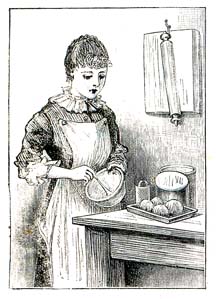
There’s a ton of confusing information floating around about what makes a healthy diet. What always makes me laugh is when people say we should only eat what our grandparents would recognize as food (My grandpa ate salt pork on bread for lunch as a kid in Oklahoma, but I digress). I have a feeling those who tout the Grandparent Diet would be absolutely shocked to learn what our forebears considered a good meal, a snapshot of which can be found in Our Mite For the Kitchen.
Put out in 1887 by the Woodland chapter of the Ladies of the Episcopal Mite Society, Mite was obviously meant as a fundraising item, with recipes furnished by the Society’s members and advertisements sprinkled liberally throughout. The edition I read is a facsimile of someone’s personal copy, including notes and corrections. As to the recipes, Mite runs the gastronomical gamut. Quite a few of them look delectable, like chocolate drops and fresh strawberry pie. Victorians must have really liked their sponge cake as well, because Mite boasts no less than seven different recipes for it. Desserts make up Mite‘s bulk, and my guess is those may have been its major selling point, since sweets can be pretty hard to turn down. There’s also no shortage of the innovative in Mite, at least by today’s standards. It includes instructions on how to make cottage cheese and chili sauce (separately, of course), as well as yeast. Yes, yeast. Three recipes, presumably for brewing and baking alike. Two of them are made with potatoes. Maybe there were those in Woodland who enjoyed making a little vodka on the sly, who knows.
Plenty of what’s in Mite is just downright strange. For instance, what is Lucca oil? One of the salad dressing recipes called for it, so apparently it was some kind of olive oil. And why would someone brew their coffee with a beaten egg in it? The recipe said to put it in a cup with cold water and add temporarily to boiling coffee. The only thing I can figure out is maybe it kept the coffee from over-brewing, but either way it’s unusual. There’s also a chicken soup made with beef broth and eggs. That’s it. Just eggs. No chicken meat, no noodles, nothing. Mmm mmm good. Then there are two chocolate cake recipes that don’t have any chocolate in them. Guess the chocolate part was to taste.
Beyond that, cooking methods have changed a lot, even just since the Victorian era. Obviously, we don’t use fireplaces or coal and wood stoves as much anymore, but that isn’t the biggest shift. Standardized measurements didn’t exist until Fannie Farmer’s famous cookbook was published in 1896. Since their book predated Fannie’s, Mite’s contributors couldn’t use these. Ergo, the book includes such seat-of-the-pants amounts as “butter the size of a walnut” in the potato soup and “one teacup chopped nuts” in the cream nut cake. Cooking techniques were vastly different as well, and would make modern cooks and chefs cringe. Mite advised boiling—not simmering—vegetables anywhere from twenty minutes to an hour or more. Good grief, those vegetables would have been mush by the end, not to mention all the vitamins boiled out. The recipe for roast turkey also made me shake my head, as it called for moistening the bird with milk. Yikes. I wonder how many cooks found their kitchens full of smoke when they attempted this recipe.
Believe it or not, Mite gets even stranger. It’s no secret that Victorians had some weird methods of handling illness, but how about feeding it? An invalid in 1887 might be treated to such delicacies as grated bread, tapioca jelly, farina gruel, or my personal favorite(!), bonny clabber. My husband’s eyebrows almost jumped off his face when I read him that recipe, which featured loppered milk and nutmeg. The section was clearly meant for those who had typhoid or some other illness that made it impossible to take solid food, but wow. It was no fun being sick in the Victorian era. Mite also delved briefly into household remedies and cosmetics. Their hair tonic recipe called for, among other things, borax and ammonia. Seeing as Victorians didn’t wash their hair all that much, super-drying additives like these probably didn’t faze them. They also included a rheumatism ointment, which contained hemlock and skunk oils. I really do not want to know how they obtained those ingredients.
Our ancestors definitely did not have a diet as pure as the driven snow. There’s a reason we cook the way we do today, and books like Our Mite For the Kitchen are good little reminders of how far we’ve come. It is nothing if not a pleasantly memorable jaunt into the wonders of Victorian cuisine.

One thought on “Bon Appetit”